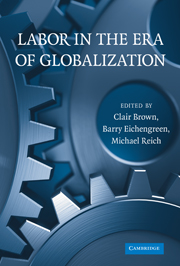Book contents
- Frontmatter
- Contents
- Tables and Figures
- List of Authors and Editors
- Introduction: Labor in the Era of Globalization
- PART ONE POLITICAL ECONOMY AND LABOR MARKET INSTITUTIONS
- PART TWO INSTITUTIONS AND FIRM AND WORKER BEHAVIOR
- PART THREE CONTEMPORARY LABOR–MANAGEMENT RELATIONS
- 7 The New Treaty of Detroit: Are VEBAs Labor's Way Forward?
- 8 Symphony Musicians and Symphony Orchestras
- 9 Wage Effects of Works Councils and Collective Agreements in Germany
- 10 Apprentice Strikes, Pay Structure, and Training in the Twentieth-Century UK Metalworking Industry
- PART FOUR PUBLIC POLICY AND U.S. LABOR-MARKET STRUCTURE
- Index
- References
9 - Wage Effects of Works Councils and Collective Agreements in Germany
Published online by Cambridge University Press: 05 June 2012
- Frontmatter
- Contents
- Tables and Figures
- List of Authors and Editors
- Introduction: Labor in the Era of Globalization
- PART ONE POLITICAL ECONOMY AND LABOR MARKET INSTITUTIONS
- PART TWO INSTITUTIONS AND FIRM AND WORKER BEHAVIOR
- PART THREE CONTEMPORARY LABOR–MANAGEMENT RELATIONS
- 7 The New Treaty of Detroit: Are VEBAs Labor's Way Forward?
- 8 Symphony Musicians and Symphony Orchestras
- 9 Wage Effects of Works Councils and Collective Agreements in Germany
- 10 Apprentice Strikes, Pay Structure, and Training in the Twentieth-Century UK Metalworking Industry
- PART FOUR PUBLIC POLICY AND U.S. LABOR-MARKET STRUCTURE
- Index
- References
Summary
INTRODUCTION
The effects of German industrial-relations institutions on wages have been analyzed in several studies. Some investigations focus on the impact of collective agreements on wages, whereas other studies – considering the specific German institutional setting – concentrate on the wage effects of works councils. The interactive role of both institutions in the wage-determination process is frequently neglected. In the framework of a binding collective contract, which resolves or, at least, attenuates distributional conflicts, works councils on the one hand could be more willing to invest in trust and cooperation and less inclined to use their rights to counteract decisions of management with the goals of redistributing economic rents and raising wages. On the other hand, works councils – in conjunction with the union that negotiated the collective contract – could mutually strengthen their respective bargaining power and exert a stronger impact on wages.
In this chapter, we analyze the nexus of wages and industrial-relations institutions – specifically, collective contracts and works councils. In a first step, we concentrate on two periods, 2000/2001 and 2004/2005, and estimate the effects of works councils on wages for firms covered and not covered by a collective contract using cross-sectional firm data. Because the Works Constitution Act was reformed in 2001 (effective in 2002) – with the political goals to facilitate the creation of works councils, strengthen the access of unions to firms, and expand the rights of works councils – we analyze whether the wage effects of works councils differ between the two periods.
- Type
- Chapter
- Information
- Labor in the Era of Globalization , pp. 295 - 316Publisher: Cambridge University PressPrint publication year: 2009

